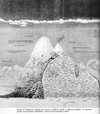Meeting 15 • 25 February 2014
|
Version: |
|
pictures of the week
|
|
|
|
mini-text of the week (start): "…we forgot that there might be dangers descending steep slopes covered with a smooth, slippery grass in the dark."Humboldt, "Personal Narrative", from Jaguars and Electric Eels, ed. & trans. Wilson, pp. 17-18 (read more) |
|
•√ (05') Mini-text of the week: Who has gotten lost in the Big World Out There, perhaps on a steep place in a dark place? An example: the volcanic cliffs above Honolulu - not really lost, but kind of stranded |
|
•√ (05') Thought-bite of the week: What KINDS of data are necessary for: a) detection and measurement of whatever climate change, environmental degradation, species loss may be occurring (did once occur), and how do we obtain that information? (more about this in a meeting or two); and for b) systematic / objective discussion of sustainable environmentalism? |
|
•√ (10') Small-group discussion and reporting out to main group: Where in our COURSE (readings? discussions? handouts? own INQuiries?) have we already encountered the ORIGINS of sustainable environmentalism? |
|
•√ (10') But why would / should / could anyone care / worry about the environment? What categories of thought are parts of the question? (tdjfodf - science, of course; but also fdpo - economics, nfubqiztjdt / fuijdt / sfmjhjpo - metaphysics / ethics / religion). What concepts must be there, and when - if they have not been around forever - did they become available? (tqfdjft - dsfbujpo & FYUJODUJPO - species, creation, EXTINCTION; effq ujnf - vojwfstf, fbsui & "fwpmvujpo" - deep time - universe, earth, "evolution" - an idea which had to develop considerably before Darwin took it up) The "Long-Beaked Echidna" - environmentalism and economics (The Economist, Feb. 22 2014, p. 66). If time: groups help edit an awful sentence in the article. Environmentalism v. Sustainable Environmentalism (John Muir, Gifford Pinchot [the person, the National Forest]); early stage v. later stage of modern environmentalism; preservation v. conservation). Recommended book: The Big Burn, by Timothy Egan |
|
•√ (10') Species descriptions, with work samples. Important: Don't write as though you yourself were the audience, as though you were writing a biology paper, or even as though I were the ultimate audience. Picture a distinct category of learner and work from there. Hallmarks / gauges of strong species descriptions / group projects: 1) Is it about you or about sustainable environmentalism and AvH? 2) Will your audience learn ABOUT or learn TO, or both? 3) Could a teacher use your activity a) as is; b) by adding something to it? 4) Does it contribute balance to a larger effort (or is it just another take on the penguin / squid)? 5) Could you confidently present it publicly? Example: PSU Student Research Symposium |
|
•√ (15') Speaking of species: what it's like to read Darwin's big book. Close comparison of the final beautiful paragraph in two editions. The immensely complicated issue of evolution, religion, politics, and eugenics, with an example from a biology textbook required in one American state (Hunter). |
|
•√ (05') Group projects: concept of Big IDEA for Major Project, rather than finished, packaged product (though Big Ideas still have to be presented in effective packages). Reasons: a) never enough time; b) there wiu=ll be later Humboldt SINQs, and of course there is the larger Humboldt Project, and maybe some time even a Humboldt Capstone. This course's group projects could be handed off (anonymously) to your successors for further development. Into the projects we'll integrate the species descriptions and the foundation for learning materials of use to Humboldt-named schools, or just about any school. You learn best when you have to teach what you've learned. To be an educated, committed citizen is both to learn and to teach. More examples - "Humboldt and Indigenous Cultures / Peoples /'Races'"; "Humboldt - You've Read the Novel, Now Go to the Play / See the Movie"; "Humboldt-Themed Student-Created Businesses (coffee, chocolate, Humboldt-branded articles made from Humboldt-related materials) |
|
•√ (10') Examples of lesson plans that can guide species descriptions and some group projects: 1) see handout for previous meeting; b) here is "ThirteenEd Online", about lesson plans (example: math). For the Bigger Picture about principles, stakeholders, etc., see PSU/Oregon "STEM+German" grant-funded project. |
|
•N (05') If time: grants, jobs, résumé lines through PSU Institute for Sustainable Solutions; grants and conferences elsewhere; see earlier handouts for examples of internships. More soon about documenting your skills / achievements and the larger topic of employability. |
|
• (0') Coffee / snack after class Thrusday? Lunch / Coffee Friday noonish? |
|
• On the horizon: Soon: A last quantification activity: precise measurement of altitude / distance (demo, then do in groups). Thought questions: Are all angles and degrees created equal? Why use a barometer to measure altitude when the theodolites and trig tables are there? Margins for error in Humboldt's time and our own: latitude, longitude, altitude, temperature; news flash: PSU Building World's Biggest Barometer!! Soon: topographical mapping and iso-dimensions Looking further ahead (projects, etc.): presentation (continuation) about educational standards and their parts in the course: 1) Improving your learnign by helping others to learn - This is preparation for assignments about species description and group projects. looking ahead: presentation of project ideas (just the ideas, not finished projects) at meeting #16 Later: the iconic graphic of Chimborazo, and similar uses of graphics in delivering data and concepts; Upcoming: presentation about society back then (and any time before 1800 or so), to help understand how H related to people of other classes / races (teaser: When was it that someone's ears first popped with a change in altitude?) advice about "educated citizen" reading, with a short sample http://www.literature.org/authors/d |

